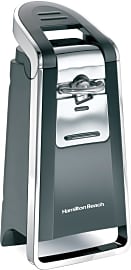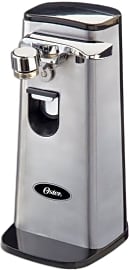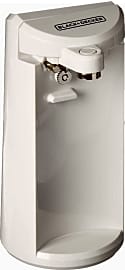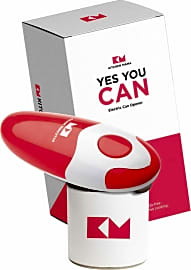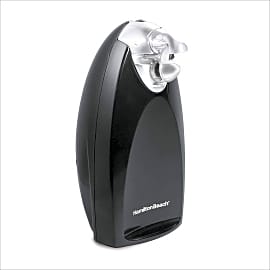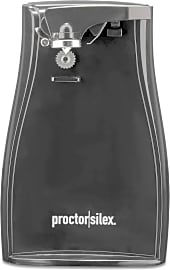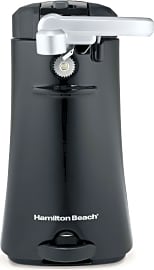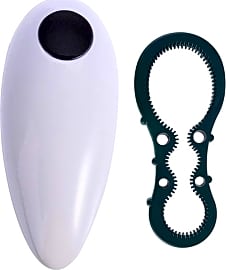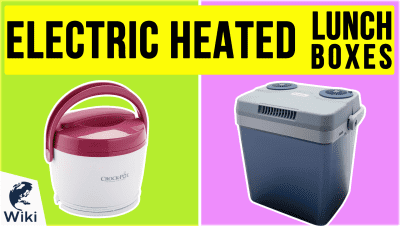The 10 Best Electric Can Openers

This wiki has been updated 38 times since it was first published in June of 2015. Save your energy in the kitchen for coming up with elaborate new recipes by using one of these electric can openers. They come in various designs to suit nearly any decor and space restrictions, and can either sit on the counter, mount under a cabinet, or stay out of the way in a drawer until you need them. Many also offer other convenient gadgets to open jars, bags and bottles. When users buy our independently chosen editorial selections, we may earn commissions to help fund the Wiki.
Editor's Notes
November 30, 2020:
Electric can openers seem to fall into two distinct types; there are small, battery-powered options that rotate on top of your cans, and larger, free-standing models (that you usually plug into the mains) that rotate the entire can, suspending it beneath an arm. We've included three of the former and seven of the latter to give you an idea of what's on offer.
We removed the Black and Decker Spacemaker (an example of a third type of opener that's mounted underneath your worktop) as its price point was far too high for something that opens cans and couldn't be justified all things considered. Instead, we added the Oriflame One-Touch Switch, another of the compact, mouse-like devices that you set on top of the cans. Along with the Kitchen Mama CO1100 and the Zyliss EasiCan E930038U, these options are a really good choice for senior citizens and those suffering from rheumatic conditions as the operation is completely hands-free and there doesn't seem to be any issues of having to correctly align your cans like the freestanding options sometimes incur.
We replaced the Oster Tall 003147 with the much more popular Oster FPSTCN1300, an almost like-for-like swap, as they're both built to accommodate taller cans (like the Proctor Silex 75217F and the Hamilton Beach Smooth Touch 76606ZA), except the Oster FPSTCN1300 has a more durable (and better-looking) stainless steel arm, and an integrated bottle opener on the front.
November 15, 2019:
There can be several frustrating parts of trying to pry open a can, and it can often be a messy job, so we made sure our selection of openers boast features to make the whole process more seamless.
We wanted to show that even electric models could still be as compact as the manual versions, so we included the Kitchen Mama CO1100 and the Zyliss EasiCan E930038U, both of which are small, lightweight, and ergonomic. They're also easy to toss in a picnic basket or lunchbox. We removed the Bangrui Smooth Edge, as many complain it can get jammed in the middle of a job, and be quite difficult to pry off a lid.
We also wanted to include some options that could accommodate extra-tall cans, and even though we removed the West Bend 77203 since the manufacturer discontinued it, we still have the Proctor Silex 75217F and the Oster Tall 003147, which can handle lengthier tins.
Fear of cutting oneself is always a concern when taking the lid off of a can, so we removed the Sokos CN180 as many complain it creates sharp edges. We particularly like that the Hamilton Beach Smooth Touch 76606ZA has a side-cutting system to minimize the risk of sharp edges, so it continues to rank quite well.
A few models that can handle various kitchen tasks caught our attention, too, like the Black & Decker Spacemaker, with its quality knife sharpener to keep those kitchen knives in working order, and the Hamilton Beach OpenStation 76389R, which has integrated tools to take lids off of jars, pop caps off of bottles, and cut through tough plastic packages.
Special Honors
The Edlund 266 Single Speed If you have a restaurant or catering company and must open hundreds of cans a day, this industrial-grade opener can handle the job. Even though it's powerful, it has a small footprint relative to a commercial space. Made of stainless steel, it should hold up to plenty of use, and it's available in a 115- or 230-volt capacity. edlundco.com
A Brief History Of Canned Food
It would not be until the early 19th Century that a reliable method for preserving food in a state approximating freshness was devised.
Maintaining a ready supply of safe, nutritious food has been one of the greatest challenges humankind has faced since time immemorial. In the distant past, access to a food supply dictated where a group of people could establish a settlement, or would deter permanent settlement and instead dictate a mobile, nomadic lifestyle. Methods of food preservation would extend the flexibility some cultures enjoyed, giving easier access to food during the winter months when food sources were less abundant in northern regions, and offering travelers, soldiers, or itinerant cultures easier access to food.
Ancient methods of food preservation -- many of which are still practiced today, though primarily for flavor preference purposes, and not to ensure basic sustenance -- included salting meats and pickling vegetables, drying, roasting, or smoking various foodstuffs, and through the fermentation of various wheats, fruits, and other edibles into safe, calorie-rich beverages. (The production of primitive types of beer was almost surely the catalyst for the earliest grain harvests, not for the making of bread. Though the beverages produced were likely created for sustenance, not for inebriation -- that was merely a happy coincidence.) Salted, smoked, or dried foods certainly lasted much longer than fresh foods, but even these did not present a true solution to long term food stability, at least not in the eras long preceding reliable packaging and refrigeration.
It would not be until the early 19th Century that a reliable method for preserving food in a state approximating freshness was devised. The first truly safe canned foods -- those that in today's parlance would be called shelf stable -- were produced in France during the Napoleonic Era. And indeed it was the many wars and long military campaigns of this tumultuous time that spurred the development of the cannoning technology, for as the old adage goes, "An army marches on its stomach." Or, in other words, the French troops needed food if they were to fight and conquer. (Ironically, this quite has been attributed to both Napoleon and to Frederick the Great, the champion of a kingdom that would later serve as one of Napoleon's greatest foils.)
A young man named Nicolas Appert, formally a chef for the fallen French royalty, took up a challenge issued by the French government to create a way to preserve foods for long term stability. Initially using champagne bottles, which could be sealed extremely well, preventing any air from contacting foods, Appert devised the first effective way to preserve foods in the year 1903. When he and his team made the switch to wider mouthed glass jars, they created the first practical way to store food. Before long, they had settled on tin cans, which could be soldered shut to ensure an airtight seal, as they drew near to the canning methods still employed today. With the addition of the methods of pasteurization pioneered by the eponymous Louis Pasteur in the 1860s and improvements made to both canning and can opening technology -- the "double seam" can, to be precise -- in the early 20th Century, canned food as we still know it today had arrived well over a hundred years ago.
Why Electric Can Openers Are Logical, Not Luxuries
Whether used just a few times a year or used daily, an electric can opener is one of the most useful kitchen gadgets available, and one of the most affordable, too. For the latter reason alone it makes sense to use an electric can opener even if you seldom open cans. And if you open cans of food, sauce, soup, or stock regularly, there are myriad reasons to choose an electric can opener, while price is no prohibition. (Even high end electric can openers usually come in at a moderate price point.)
For some people, electric can openers are not just useful, they are necessary. If you suffer from arthritis, carpal tunnel syndrome, or if you have wrists or hands weakened to due injury, illness, or the simple infirmities of age, a reliable electric can opener is a must have when you want to prepare a nourishing meal. And even for the hale and hearty who have simply injured one hand temporarily, an electric can opener is a wise choice for use during convalescence and beyond.
And even those with strong, supple wrists can experience pain and soreness after opening multiple cans using a manual opener. If you make large batches of pasta sauce or gravy or if you find yourself often opening cans for many people at the same time, then treat yourself to an electric can opener and save your wrists and hands from the strain.
Choosing The Right Electric Can Opener
As noted above, electric can openers are surprisingly affordable, so your choice can come down to whichever design you prefer. There are electric can openers that you set on the counter and there are options you perch atop your can. Some mount permanently underneath a cabinet, while others can be tucked away in a drawer.
One of the main considerations is whether or not you prefer a can opener that makes a side cut. This approach doesn't cut the lid out of the can, but slices it off entirely, usually leaving a smooth edge. Just note that some side cut openers require two passes to fully remove the lid, so if you value efficiency and don't mind being careful around those open cans, top cut options may be your better choice.
Ultimately your choice of can opener might just come down to kitchen storage space. Some electric can openers are about the size of a loaf of bread, while some are not much bigger than the cans of food they open.


